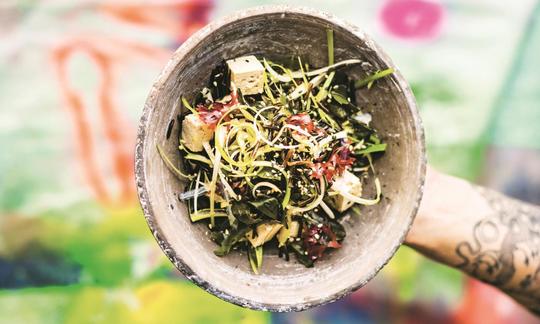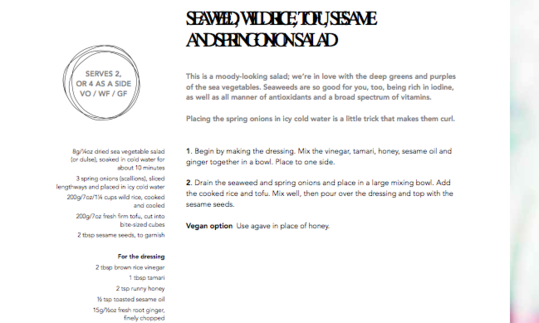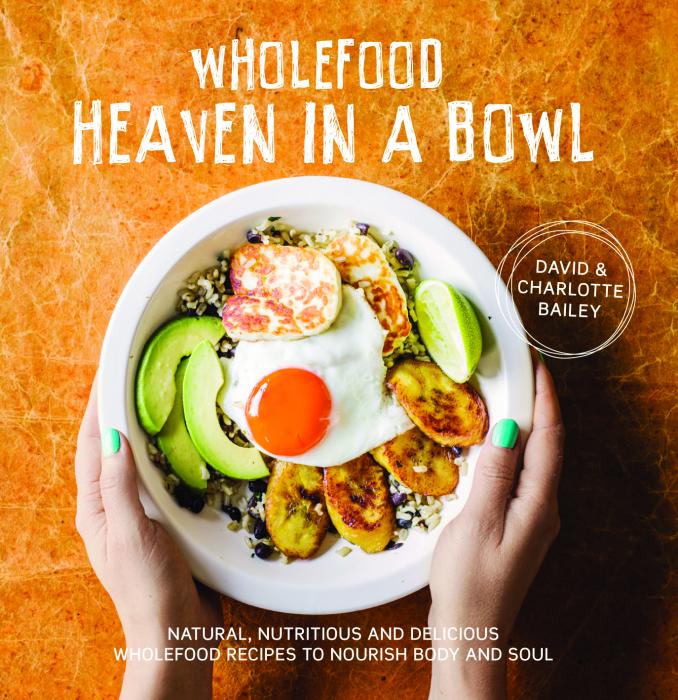Seaweed, Wild Rice, Tofu, Sesame, and Spring Onion Salad
vegan
Ingredients (for servings, )
| Preparation (can be done the day before) | |
|---|---|
| 2 ½ oz | Wild rice (water rice, raw?, organic?) |
| For the salad | |
| ¼ oz | Dulse (dried, raw?, organic?) |
| 3 | Spring / leek / winter onions, raw, organic? (6.1 oz) |
| 7 ⅓ oz | Tofu, tasteless (bean curd) |
| 2 tbsp | Sesame, raw, unpeeled (sesame seeds, organic?) (0.63 oz) |
| For the dressing | |
| ½ oz | Ginger, raw (organic?) |
| 2 tbsp | Rice vinegar, rice wine vinegar (organic?) (1.0 oz) |
| ½ tbsp | Soy sauce (tamari, organic? raw?) (0.32 oz) |
| 2 tbsp | Agave syrup (agave syrup, raw?, organic?) (0.82 oz) |
| ½ tsp | Sesame oil, roasted (organic?) (0.08 oz) |
Equipment
- rice cooker or saucepan
- vegetable peeler
- stove
- sieve
Type of preparation
- cook
- soak
- peel
- drain
Preparation
Preparing the wild rice
Cook the wild rice in a rice cooker. Alternatively, bring three times as much water as rice to a boil, stir in the wild rice, and simmer covered 40–45 minutes. When finished, let the rice cool.In the meantime, you can continue with the following steps.
The original recipe that makes 4 servings calls for 200 g (1¼ cups) cooked wild rice.
You can also prepare the rice the day before and keep it in the fridge. This will decrease the preparation time significantly.
Soaking the seaweed
Place the seaweed (or dulse) in a bowl with cold water and soak for about 10 minutes.While the dulse is soaking, continue with the next step.
The original recipe for 4 servings lists 8 grams dulse as an alternative to the same amount of dried sea vegetable salad. However, dried dulse can be used without soaking. If you are using dulse, this preparation step is therefore optional.
Prepare the remaining ingredients for the salad
Slice the scallions (spring onions) lengthways and place in icy cold water. Cut the tofu into bite-size pieces and set to the side.For the dressing
Peel and finely chop the ginger. Mix the vinegar, soy sauce (tamari), agave syrup, sesame oil and finely chopped ginger together in a bowl. Place to the side.We’ve chosen the vegan option of using agave syrup in place of honey.
In addition, we have cut the amount of soy sauce in half in order to reduce the salt content.
Finishing the salad and serving
Drain the scallions and place the scallions and dulse in a large mixing bowl. Add the cooked rice and tofu. Mix well and then pour the dressing on top and garnish with the sesame seeds.
|
Nutritional Information per person
Convert per 100g
|
2000 kcal | |
|---|---|---|
| Energy | 212 kcal | 10.6% |
| Fat/Lipids | 7.2 g | 10.3% |
| Saturated Fats | 1.0 g | 5.2% |
| Carbohydrates (inc.dietary fiber) | 27 g | 10.0% |
| Sugars | 6.7 g | 7.4% |
| Fiber | 3.0 g | 12.1% |
| Protein/Albumin | 11 g | 22.6% |
| Cooking Salt (Na:148.0 mg) | 376 mg | 15.7% |
| Essential micronutrients with the highest proportions | per person | 2000 kcal | |
|---|---|---|---|
| Vit | Vitamin K | 94 µg | 125.0% |
| Min | Iod, I (Jod, J) | 151 µg | 101.0% |
| Min | Copper, Cu | 0.55 mg | 55.0% |
| Prot | Tryptophan (Trp, W) | 0.13 g | 54.0% |
| Min | Manganese, Mn | 1.0 mg | 51.0% |
| Elem | Magnesium, Mg | 177 mg | 47.0% |
| Vit | Vitamin B9, B11 (Folate, as the active form of folic acid) | 88 µg | 44.0% |
| Prot | Threonine (Thr, T, irreversibly transaminated) | 0.40 g | 43.0% |
| Prot | Isoleucine (Ile, I) | 0.44 g | 36.0% |
| Elem | Phosphorus, P | 245 mg | 35.0% |
Detailed Nutritional Information per Person for this Recipe
The majority of the nutritional information comes from the USDA (US Department of Agriculture). This means that the information for natural products is often incomplete or only given within broader categories, whereas in most cases products made from these have more complete information displayed.
If we take flaxseed, for example, the important essential amino acid ALA (omega-3) is only included in an overarching category whereas for flaxseed oil ALA is listed specifically. In time, we will be able to change this, but it will require a lot of work. An “i” appears behind ingredients that have been adjusted and an explanation appears when you hover over this symbol.
For Erb Muesli, the original calculations resulted in 48 % of the daily requirement of ALA — but with the correction, we see that the muesli actually covers >100 % of the necessary recommendation for the omega-3 fatty acid ALA. Our goal is to eventually be able to compare the nutritional value of our recipes with those that are used in conventional western lifestyles.
| Essential fatty acids | per person | 2000 kcal |
|---|---|---|
| Linoleic acid; LA; 18:2 omega-6 | 3.3 g | 33.0% |
| Alpha-Linolenic acid; ALA; 18:3 omega-3 | 0.34 g | 17.0% |
| Essential amino acids | per person | 2000 kcal |
|---|---|---|
| Tryptophan (Trp, W) | 0.13 g | 54.0% |
| Threonine (Thr, T, irreversibly transaminated) | 0.40 g | 43.0% |
| Isoleucine (Ile, I) | 0.44 g | 36.0% |
| Valin (Val, V) | 0.55 g | 34.0% |
| Leucine (Leu, L) | 0.72 g | 30.0% |
| Phenylalanine (Phe, F) | 0.46 g | 30.0% |
| Lysine (Lys, K, irreversibly transaminated) | 0.45 g | 24.0% |
| Methionine (Met, M) | 0.19 g | 20.0% |
| Vitamins | per person | 2000 kcal |
|---|---|---|
| Vitamin K | 94 µg | 125.0% |
| Vitamin B9, B11 (Folate, as the active form of folic acid) | 88 µg | 44.0% |
| Vitamin B2 (Riboflavin) | 0.24 mg | 17.0% |
| Vitamin C (ascorbic acid) | 12 mg | 15.0% |
| Vitamin B3 (Niacin) | 2.4 mg | 15.0% |
| Vitamin B6 (pyridoxine) | 0.21 mg | 15.0% |
| Vitamin B1 (Thiamine) | 0.10 mg | 9.0% |
| Vitamin B5 (Pantothenic acid) | 0.34 mg | 6.0% |
| Vitamin E, as a-TEs | 0.77 mg | 6.0% |
| Vitamin B7 (Biotin, ex vitamin H) | 3.0 µg | 6.0% |
| Vitamin A, as RAE | 29 µg | 4.0% |
| Essential macroelements (macronutrients) | per person | 2000 kcal |
|---|---|---|
| Magnesium, Mg | 177 mg | 47.0% |
| Phosphorus, P | 245 mg | 35.0% |
| Calcium, Ca | 184 mg | 23.0% |
| Potassium, K | 436 mg | 22.0% |
| Sodium, Na | 148 mg | 18.0% |
| Essential trace elements (micronutrients) | per person | 2000 kcal |
|---|---|---|
| Iod, I (Jod, J) | 151 µg | 101.0% |
| Copper, Cu | 0.55 mg | 55.0% |
| Manganese, Mn | 1.0 mg | 51.0% |
| Iron, Fe | 4.8 mg | 34.0% |
| Zinc, Zn | 2.6 mg | 26.0% |
| Selenium, Se | 11 µg | 20.0% |
| Fluorine, F | 13 µg | < 0.1% |
Pavilion Books Company Ltd, David and Charlotte Bailey
Raw recipes 11, Cooked recipes 58 (4)
Additional photos (7)
“Wholefood Heaven in a Bowl – Natural, Nutritious and Delicious ...,” a Middle Eastern vegetarian cookbook with a strong focus on wholefoods.
SummaryWholefood Heaven in a Bowl – Natural, Nutritious and Delicious Wholefood Recipes to Nourish Body and Soul by David and Charlotte Bailey is a vegetarian cookbook that includes many vegan recipes. It is a good cookbook both for those who have experience with a vegan and/or vegetarian diet and those who are just starting out and are ready to try healthier options. The recipes are international and have a special focus on Asian cuisine; they range from easy to prepare to more challenging dishes.
| Critical book reviews It is not common practice for us to use a vegetarian cookbook as a source, but about 70 % of the recipes in this cookbook are vegan. These are the only type we have on our website. |
Overall impressionIn their cookbook Wholefood Heaven in a Bowl – Natural, Nutritious and Delicious Wholefood Recipes to Nourish Body and Soul, David and Charlotte Bailey have selected recipes with naturally healthy ingredients. The recipes include vegetables, fruits, nuts, seeds, and grains that have been processed and refined as little as possible. David and Charlotte Bailey use a lot of whole grains and ancient grains and avoid highly processed foods and food additives. They also try to keep the amount of added salt, sugar, and oil to a minimum. It is therefore somewhat surprising that canned foods such as legumes or tomatoes are sometimes called for in the recipes. However, this does not occur very often.
It is helpful that above each recipe the authors have listed whether it is a vegan recipe, includes vegan options, if it includes grains, and if it is gluten-free. Tofu products are found in some recipes but are the exception. You will notice right away that the recipes contain a large number of spices. The dishes are international, and many are clearly influenced by Asian cuisine. The ingredients themselves are readily available. Alongside simple and quick dishes, you will also find quite complicated recipes that require planning and time to prepare. However, it would be nice if the recipes, especially the more involved ones, included the preparation time needed. Since most people will not be familiar with recipes like these, it would be nice if there were photos for all of the recipes and not just for most of them.
Wholefood Heaven in a Bowl is a book that has a strong emphasis on health and features many extraordinary, one-of-a-kind recipes. It is a cookbook that offers even experienced vegan cooks numerous new ideas for recipes.
David and Charlotte Bailey have written two books: Wholefood Heaven in a Bowl and The Fresh Vegan Kitchen, both of which are available from Pavilion books and Amazon.
About the authorsDavid Bailey, who has several years of experience working in top restaurants, and his wife Charlotte started their business Wholefood Heaven in 2010. They sell vegetarian street food at markets, festivals, and other events. Their famous Buddha Bowl won the 2011 British Street Food Awards for Best Main Dish. In addition to their business, they are continually developing new recipes and writing cookbooks.
ContentsWholefood Heaven in a Bowl – Natural, Nutritious and Delicious Wholefood Recipes to Nourish Body and Soul begins with an introduction that explains the terms “wholefoods” and “bowls.” The chapter “Wholefood Store Cupboard” provides information about a wide range of ingredients that come under the categories of whole grains, flours, legumes (pulses), nuts and seeds, herbs and spices, tofu and soya chunks, and other things.
The recipes are divided into seven sections:
- Breakfasts and brunch
- Salads
- Soups and stews
- Mains
- Accompaniments and sides
- Baking and desserts
- Drinks
Breakfast and brunch: This chapter is full of sweet and savory international breakfast and brunch options — from muesli to pancakes and the like. Only one recipe is vegan, but two have vegan options. Most of the other vegetarian dishes contain egg and about half of them dairy products. Examples of recipes in this section are Chia Seed Bircher Bowl and Millet Porridge with Prune Compote and Flaked Almonds.
Salads:Most of the salads call for cooked ingredients such as grilled vegetables or grains and therefore are not raw food dishes. Four of the eight recipes are vegan, and two more include vegan options. Seaweed, Wild Rice, Tofu, Sesame and Spring Onion Salad and Wholegrain Glass Noodle Salad with Smoked Tofu and Mixed Sprouts are just two examples of the recipes in this section.
Soups and stews: All of the recipes in this section are vegan or include vegan options. You might try, for example, Sweet Potato and Coconut Soup with Toasted Pumpkin Seeds or the Vietnamese-inspired Pho with Pak Choi, Edamame and Brown Rice Noodles. Apart from canned coconut milk, canned ingredients (here: beans) are only called for on one occasion.
Mains:About two-thirds of the recipes in this largest section of the cookbook are either vegan or include vegan options. About one-third calls for soy products (e.g., tofu or soya chunks) or canned ingredients. Many of the recipes require several ingredients, which means that they take more time and effort to prepare. Some examples of recipes in this section are the famous Buddha Bowl, Ethiopian Kik Alicha (split stew) with Atakilt Wat (spiced cabbage), Cucumber Salad and Injera Flatbread, and Mexican Bean Pot Bowl with Citrus Chard.
Accompaniments and sides:Apart from one exception, all of the dishes in this section are vegan. You will find fermented vegetables such as Basic Kimchi, spice pastes and savory sauces like Seeni Sambol, and vegetable sides and toppings such as Hazelnut Dukkah.
Baking and desserts:The majority of the recipes here contain either eggs or dairy products and therefore are not vegan. An example of one of the three vegan recipes is Vegan Carrot Halwa.
Drinks:Alongside Milky Masala Chai and Tiger’s Milk, this section includes numerous smoothies and refreshing drinks such as the Switchel with lemon and ginger.
Book review written by Dr. med. vet. Inke Weissenborn
This colorful salad with seaweed (dulse), wild rice, tofu, sesame, and spring onions (scallions) is refreshing and healthy. It is rich in iodine.
Servings: This dish can be served as a side (4 servings) or a main dish (2 servings).
Seaweed: Seaweed or sea vegetables are forms of algae that grow in the sea. The most widely available seaweeds are the green (sea lettuce), red (nori and dulse), and brown (kombu and wakame) varieties. Dulse, which we've used for this recipe, has a reddish-brown color, a soft, chewy texture, and a characteristic seaweed flavor. Dulse can be eaten cooked or raw and is often used in soups and salads.
Please click on the link if your health is important to you: A Vegan Diet Can Be Unhealthy. Nutrition Mistakes.
Wild rice: Wild rice is not directly related to Asian rice. It’s a long-grain marsh grass that originated in North America, India, and China and is now becoming popular in Amerika again. Since it grows in the shallow waters of lakes and rivers, harvesting and processing the rice is labor-intensive, which explains why it’s quite rare and pricy. However, today the majority of the wild rice sold is cultivated in bunded (embanked) fields. Wild rice looks like a long-grain rice covered by a brownish skin. The texture is reminiscent of brown rice and other whole grains. It has a nutty flavor.
Tofu: Also known as soybean curd, this Asian food is especially popular with vegans and vegetarians as it is an excellent source of protein. It is also lactose -, cholesterol -, and gluten-free. Plain, unseasoned tofu has very little flavor or smell of its own. However, this makes it ideal as a carrier of seasoning and flavors and explains why it can be used in so many different types of dishes. Tofu can be used in savory main dishes as well as in sweet recipes. This quality is what makes it such a versatile food. In East Asia, tofu is often eaten plain or just lightly seasoned.
Ginger: Ginger is aromatic and has a pungent, spicy taste because it contains gingerol, a substance which has anticarcinogenic and anti-inflammatory effects. Thanks to borneol and cineol, ginger promotes digestion, calms the stomach, is effective against vomiting and nausea, and stimulates the appetite and circulatory system. As a cooking ingredient, ginger root is used in several forms including fresh, dried, and ground.
Iodine and algae: With algae, you should look and see how much iodine it contains. Iodine is an essential trace element that occurs primarily in the form of iodide and is especially important for the production of certain thyroid hormones. A deficiency can cause hypothyroidism, but if you consume too much it can overburden your thyroid and be harmful to your health. The type of iodine found in algae depends on the type of algae, time of harvest, location, and processing.
Purchasing and storing seaweed: If possible, try to buy organic products because seaweed can absorb heavy metals from polluted water. Store seaweed in a cool, dry place away from sunlight.
Making your own tofu: The first step in making tofu is to prepare the soy milk. You do this by soaking the soybeans in water, puréeing them, and finishing with a cooking process. The cooking step serves to remove toxins (enzyme inhibitors) and improve the digestibility of the finished product. The next step is to coagulate the soy milk using coagulants such as calcium sulfate or nigari (in Okinawa, sea water is used here, and the final product is called Shima-dofu, or island tofu). The resulting soybean curds separate from the rest of the mixture and are then pressed into tofu cakes that are cooled and cut into the desired shape. The exact process of making tofu depends on the type of tofu being produced.






